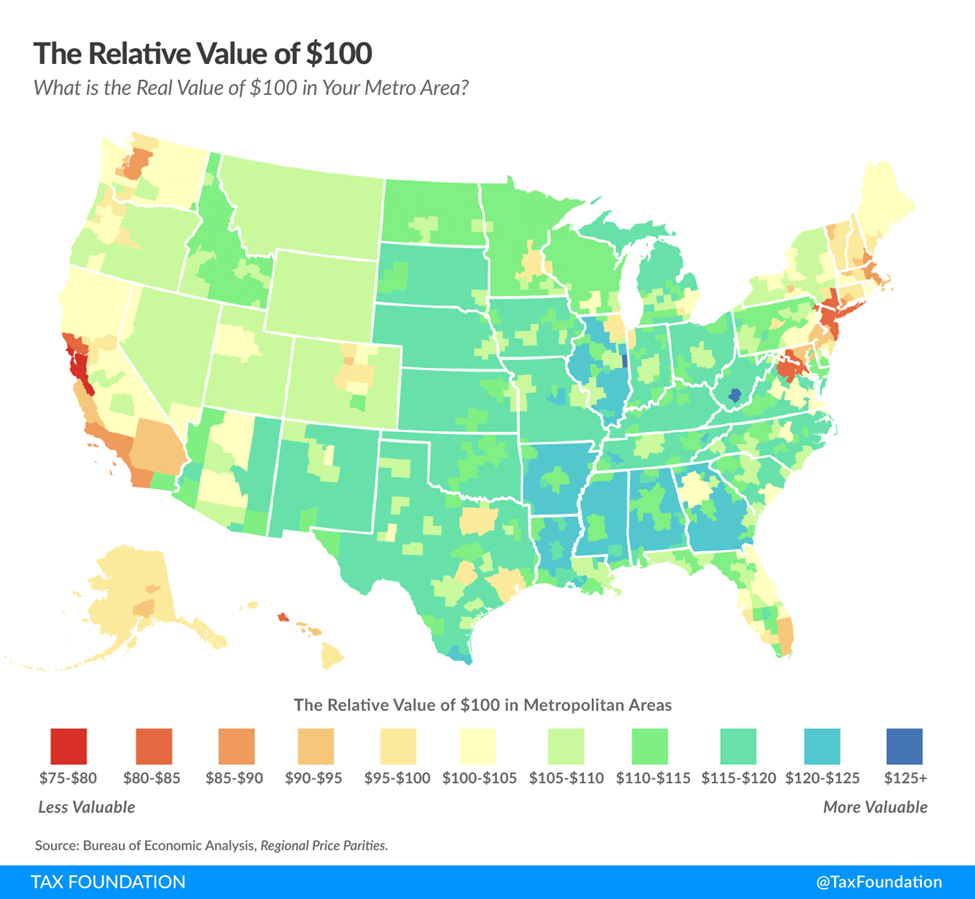Part of the Alaska, Ranked Series
It’s a commonly known and grudgingly accepted fact for most people who choose to live in Alaska: Expect to pay higher prices. The Tax Foundation recently published several informative maps, compiled from 2018 data released by the U.S. Bureau of Economic Analysis (BEA), that illuminate the purchasing power of Americans based on where they live.
Purchasing power is, simply put, how much one can buy with a certain amount of money. The BEA captures data on regional purchasing power, in addition to real personal income by state and metropolitan area.
On the map below, the Tax Foundation delineates the relative value of $100 by state – in other words, how many goods and services can one buy with $100 in each state. With the national average as a baseline, the map shows the states in which $100 goes a relatively long way and where it doesn’t go very far at all. In Maine, prices match national averages, so the state has an exact $100 on the map. For states with higher-than-average prices, $100 will buy comparatively fewer goods – these are states with values below $100 on the map. For states with lower-than-average prices, $100 buys comparatively more, reflected by values of over $100 on the map.

In low-cost states, people can purchase more goods and services with the same amount of money than on average. In Arkansas, which ranked first in the state-by-state ranking, $100 buys $117.23 worth of goods at the national average price level. Put another way, residents of Arkansas are about 17 percent richer than their nominal incomes suggest.
Alaska ranked 41st in the nation. For Alaskans, $100 buys $95.42 worth of goods at the national average price level. In other words, Alaskans are about 5 percent less rich than their nominal incomes suggest. Supplementary information, found in the BEA report, shows that the cost of rent in Alaska is 26 percent higher than the national average. Surprisingly, goods hovered at a price level only 2 percent higher than the national average, and other services are actually 4 percent less expensive in Alaska.
The Tax Foundation also released a more detailed map, calculating the relative value of $100 within metropolitan areas around the country. In Anchorage, $100 only buys $93.37 worth of goods and services, which is somewhat lower than the statewide average. Similarly, in Fairbanks, $100 buys $93.81 worth of goods and services.

While prices in Anchorage are about 7 percent higher than the U.S. average, rent is a whopping 34 percent higher than the average. In Fairbanks, rent is even more expensive at 42 percent higher than the national average. With goods and other services at similar price levels to the national average, it seems that the high cost of rent is what most reduces the purchasing power of Alaskans.
The Tax Foundation calculated that the states where $100 is worth the least are Hawaii ($84.67), New York ($85.91), Washington, D.C. ($86.13), California ($86.66), and New Jersey ($86.81). The states where $100 is worth the most are Arkansas ($117.23), Mississippi ($116.28), Alabama ($115.74), Kentucky ($113.90), and West Virginia ($113.90).
**********
The Tax Foundation is a nonprofit, nonpartisan tax policy nonprofit.